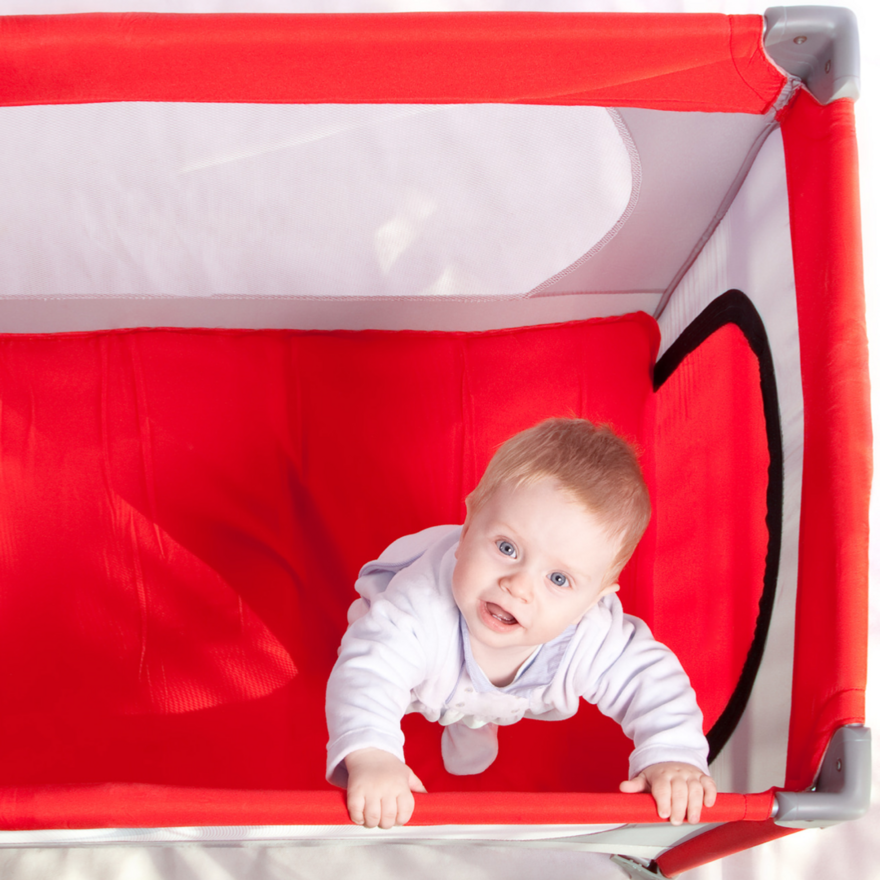Using a travel cot? Check your little sleeper is safe this holiday season

Planning on using a portable cot this holiday season? Here are some things you should know:
The most recent Australian/New Zealand standards (AS/NZS 2195:2010) for portable cots were set in 2010. Worryingly, these are OPTIONAL for manufacturers.
The mandatory standards (AS/NZS 2195:1999) were set in 1999, and do not specify the use of breathable fabric at all relevant zones around the sleep surface.
This means cots that are retailed as “meeting Australian standards” can still be a suffocation hazard.
CHOICE and Red Nose both have information about choosing and checking portable cots and sleep environments for safety, as many on the market are NOT safe. Their advice includes (but is not limited to):
- Check the cot tag to see if it meets the 2010 standard. It should say “AS/NZS 2195:2010” on it.
- Never use a cot that is broken or shows signs of wear and tear (e.g. ripped walls, broken poles).
- Make sure there is breathable mesh on all sides where the mattress meets the walls of the cot.
- The mattress should be the one made for that cot by the manufacturer and be firm. It should fit tightly into the base, which should be flat.
- Make sure there is no sheet elastic, curtains, cords or anything else sticking out that could catch a child’s clothes, choke them, restrict their movement or be used as a ladder to climb the wall of the cot.
- Remove any pillows, soft toys, cot bumpers and additional padding.
- Also check the “Product Safety Recall” website to see if the brand or model of cot has had any faults or safety issues - even those that meet AS/NZS 2195:2010 can have faults and be recalled.
If you arrive expecting a safe port-a-cot to be available and it turns out not to be the case, you may need to review your options.
- Could the cot mattress be safe if used as a floor bed, away from cords and other hazards?
- Will this be a place you visit often enough to warrant buying a safer model?
- Could it be safer for this trip if mum/parent and baby bedshare, and partner sleeps on another sleep surface?
The “Safe Sleep 7” checklist may be helpful to you in making the decision if bedsharing is an appropriate option in your personal situation.
La Leche League use this rhyme (sung to the tune of “Row, Row, Row Your Boat”) to introduce the seven criteria for safe bedsharing.
“No smoke, sober mum
Baby at your breast
Healthy baby on his back
Keep him lightly dressed.
Not too soft a bed
Watch the cords and gaps
Keep the covers off his head
For your nights and naps.”
See the official checklist, how to ensure a safe sleep surface and a discussion of risks here (which if you’ve never heard co-sleeping can be as safe or even safer than crib-sleeping for some families, you may be surprised by).
Please share with your networks so we all travel well and sleep safely this holiday season.
[Image description: a white baby stands looking up at the camera, which is positioned above them and their red travel cot. The image shows some risks, the most notable being an ill-fitting mattress and non-breathable walls.]
Categories
- News (32)
- Post-partum (62)
- Breastfeeding (20)
- Sleep (11)
- Food (6)
- Partners (16)
- Rehab (1)
- Parenting (43)
- Birth (16)
- Pandemic (14)
- Research Update (5)
- Decolonisation (2)
- Covid (14)
- Education (7)
- Motherhood (41)
- vaccines (2)
- Children (8)
- self employed (2)
- government policy (2)
- feminism (9)
- abortion (1)
- lockdown (3)
- infancy (1)
- gentle parenting (10)
- infertility (1)
- parenthood (7)
- isolation (2)
- village (5)
- Pregnancy (5)
- Podcast (2)
- Mental Health (4)
- Career (2)
- Mental Load (1)
- Community (1)
- Technology (1)
0 comments
Leave a comment
Please log in or register to post a comment